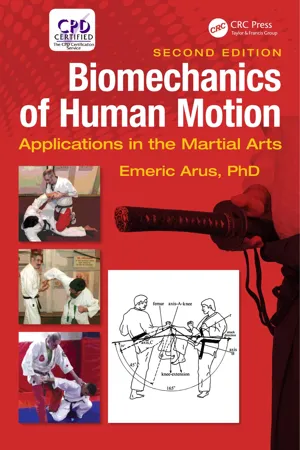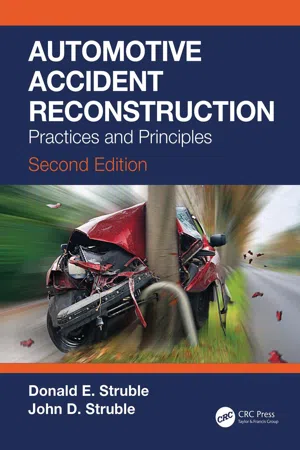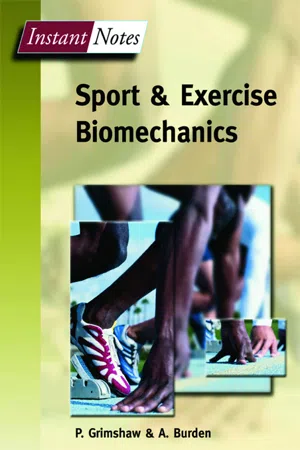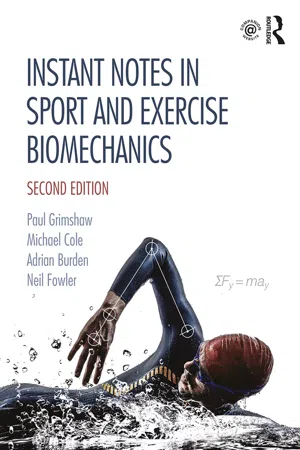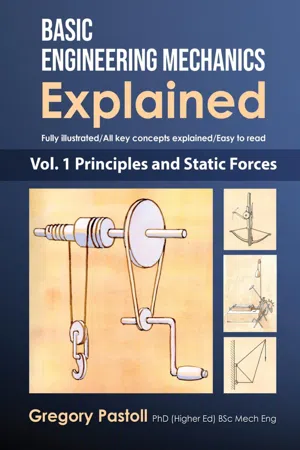Physics
Impact Forces
Impact forces refer to the forces that act on an object when it comes into contact with another object. These forces can cause a change in the object's motion or deformation. The magnitude and direction of impact forces depend on factors such as the mass, velocity, and material properties of the objects involved.
Written by Perlego with AI-assistance
Related key terms
Related key terms
1 of 4
Related key terms
1 of 3
6 Key excerpts on "Impact Forces"
- eBook - ePub
Biomechanics of Human Motion
Applications in the Martial Arts, Second Edition
- Emeric Arus, Ph.D.(Authors)
- 2017(Publication Date)
- CRC Press(Publisher)
There are many different kinds of impulses in science. In sports, there are three different kinds of impulses:- Controlled impulse refers to the muscle effort and bone leverage, for example, striking or kicking.
- Transmitted impulse occurs when, for example, a karateka is about to take off for a flying side kick. The take-off leg acts against the floor, but the magnitude and direction of impulse is determined by the free arms and leg, and not through the take-off leg.
- Physiological impulse includes the nervous impulse initiated by different agents and conditions: sound, light, taste, smell, mechanical, electrical, and so on. In our case, we will refer to the first two impulses. It is important to explain the difference between impulse and impact.
The impulse (F × time) is not a force (N), it is an integral of force over time. The impact is a force (N). Impact deals with force and of course force deals with acceleration. The impact force is usually extremely short. The impact force has the same unit as the force (F = m ⋅ a ). Impulse deals with momentum, which in turn deals with velocity. The impulse unit is kg ⋅ m/s.Impulse can be increased by adding more force to the impact or by increasing the delivery time before the impact. There is a complete inverse proportionality about the force and time used before the collision. When a large force is used, usually the time must be extremely short or when the force is reduced, then the time delivery for the force must be much longer.A body that is about to collide with another body does not change its physical shape. At the time of collision, one of the bodies or both can change their physical shape; however, they can regain their initial shape or form after the collision. In this case, we speak about elasticity of the object(s).A collision in which the total kinetic energy after the collision is less than that before the collision is called an inelastic collision. - eBook - ePub
Automotive Accident Reconstruction
Practices and Principles, Second Edition
- Donald E. Struble, John D. Struble(Authors)
- 2020(Publication Date)
- CRC Press(Publisher)
I is the yaw moment of inertia, and all four quantities are expressed in consistent units (slugs and feet, for example). Of course, moments of inertia have been measured for many vehicles and, although there may be measurement issues, the measurements can probably be used in preference to the above estimate.General Principles of Impulse–Momentum-Based Impact Mechanics
By “impulse–momentum based,” we mean the application of Newton’s Second Law, and only that principle, to the motion of vehicles involved in a crash. (Energy conservation is not utilized to obtained a solution.) As we discussed in Chapter 1 , Newton’s Second Law (change in momentum equals impulse) takes the formd(18.6)(=m)V →F →d t ,whereF →is the sum of the external forces acting on the system. The impulseis a vector, which is seen to be equal to (and therefore collinear with) the change in momentum.F →d tDifferent formulations of impulse–momentum-based impact mechanics may be obtained, depending on how one defines a system. Consider two ice-resurfacing Zamboni machines crashing on an ice rink. If a single Zamboni is defined as a system, the system is clearly receiving an impulse from the adverse Zamboni. It is also receiving a reaction force from the ice, which may be ignored because it acts perpendicular to the crash impulse. It contributes nothing to the crash other than to resist the acceleration of gravity and to maintain the Zamboni’s Z (not for Zamboni) coordinate on the ice. The Zamboni is also receiving an impulse from the friction associated with the reaction forces, which may also be ignored because the ice renders it very small compared to the collision impulse. The collision impulse is the main player in this event and must be calculated.However, if one takes both Zambonis together as a system, we know from Newton’s Third Law that the intervehicle forces (and therefore the impulses) are equal and opposite. They are internal to the system and cancel each other out. The only impulse external to the system, and contributing to the crash, comes from the friction forces. Again, these may be taken as second-order, because they are so much smaller than the collision forces. This same assumption is made in most vehicle crashes, even though they do not occur on ice (usually). For low-speed crashes, however, the collision forces may be low enough to be comparable to the friction forces, in which case the neglect of tire forces must be reconsidered. In some low-speed accident reconstructions, a time-forward simulation is used to avoid having to make what is, for those cases, an assumption that could prove to be embarrassing. - eBook - ePub
The Really Useful Science Book
A Framework of Knowledge for Primary Teachers
- Steve Farrow, Amy Strachan(Authors)
- 2017(Publication Date)
- Routledge(Publisher)
KEY IDEA 4.2 ForcesForces can make things start to move, can make moving things speed up, slow down, change direction or stop, and can make things change their shape.INTRODUCTION
Some of the difficulties that children (and adults) have with understanding forces and their effects are because:• Forces themselves cannot be seen (although their effects can).• Some forces cannot be felt.• Some of the explanations of forces and their effects appear to contradict a ‘common-sense’ view of the way in which the world works – for example, why should a small object fall to the ground at the same speed as a large object, when both are released from the same height at the same time? (See below!)• We may have limited personal experience of some of the common effects of forces in everyday life – for example, we are all affected by gravity, but how many people can really say that they are conscious of the ‘pull’ of gravity – when we lose our balance, we fall over; we do not feel as if we were pulled.• Any simple ‘earthbound’ consideration of the forces acting on moving objects is complicated by the effects of gravity, friction and air resistance (see below).Key Idea 4.1 , relating to energy, has hopefully demonstrated some of the interrelationships between such concepts as energy, work and power. The present section will introduce some of the concepts that relate to forces and their effects, and will show how and where they interact with energy, work and power.CONCEPTS TO SUPPORT KEY STAGES 1 AND 2
Some definitions
Forces are interactions between objects. In everyday terms, these interactions result in pushes and pulls, and it is sometimes helpful to make a mental substitution of the words ‘push’ or ‘pull’ whenever the term ‘force’ is encountered. This will be done in the text in the early part of the present section, so that readers can decide on its usefulness (or otherwise). - Paul Grimshaw, Neil Fowler, Adrian Lees, Adrian Burden(Authors)
- 2007(Publication Date)
- Routledge(Publisher)
u)). Impulse can be increased by either increasing the applied force or increasing the time of force application. In certain situations within human movement it is necessary to have a large force and small time of application and in other examples it is valuable to have the opposite situation.ApplicationThe shot putter in athletics applies a force to the shot for a long period of time in order to give the shot more impulse and hence a greater change in momentum (i.e., more velocity at release). The vertical (high) jumper applies a force to the ground in order to jump off the ground. The ground applies a reaction force to the jumper in order for them to be able to leave the ground. The net vertical impulse created during the preparation of the vertical jump will affect how high the athlete is able to jump. When catching a ball it is often necessary to increase the time of contact with the ball in order to reduce the force of impact (between ball and hand). This is achieved by following the ball’s direction with your hands as you make the catch (as in the case of catching a cricket ball).Impulse-momentum
The impulse–momentum relationship develops from Newton’s second law of motion (∑F = ma) and it allows us to apply this law to situations where forces are continually changing over time. For example, in many cases involving human motion forces will continuously change (i.e., they are applied over a period of time). Two rugby players who contact each other in a tackle situation will exert changing forces over time. Similarly when you run and jump on the ground you will apply forces that vary over time depending on a number of related variables: the speed of running, the surface of contact, the shoe type, the body position, and many other aspects.In human movement it is usually the effect of these changing forces applied over time with which we are concerned. It is these forces and their effects that will be used to determine performance characteristics or injury potential (outcome measures). As we apply a force over the ground with our foot during the contact phase in running what will be the outcome of this application to our running speed? Does our speed increase or do the forces acting on our legs increase to a level that could develop a potential for injury? Similarly, in the athletic event of the shot putt how does the athlete apply enough force to project the 16 lb (7.27 kg) object through the air?Fig. B3.1- eBook - ePub
Instant Notes in Sport and Exercise Biomechanics
Second Edition
- Paul Grimshaw, Michael Cole, Adrian Burden, Neil Fowler(Authors)
- 2019(Publication Date)
- Garland Science(Publisher)
This is the same principle used by a rocket or space shuttle to propel it into space. Although the rocket does not have anything to push against the external vertical force that is being exerted downward (exerted by the jet engines) onto or into the air causes an opposite (reaction) force to be exerted on the rocket (forces always come in pairs). The corresponding result (which is the net force) considering all the external forces (i.e. the vertical force acting downward from the rocket, the opposite force acting on the rocket upwards, the force of gravity pulling the rocket downward and possibly air resistance, friction and drag) accelerates the rocket vertically into the air and eventually into space. Similarly, the jet engines of a plane that are used to propel it horizontally through the air (although there are other forces such as aerodynamic lift and drag forces that also have a significant effect on the principle of flight) are acting backwards to its direction of motion (which is forwards).The application of Newton’s laws of motion is seen in many examples of human movement and a recognition of these laws can be important with regard to both injury prevention and improvement in performance. For example, how can a person reduce the potentially damaging impact force that is created during the heel strike in running (i.e. the impact force that is experienced throughout the leg during running that can be between four and five times your body weight) or how can an athlete increase the vertical component of the ground reaction force acting on the athlete at the take-off in a high jump, so that they can potentially jump higher?Key notes Newton’s laws Sir Isaac Newton formulated three laws of motion that can be applied to the study of human movement. 1 Law of inertia Every object will remain at rest or continue in its state of uniform motion unless acted upon by an external force. For example, a ball on the penalty spot in soccer is exerting a force on the ground, which is balanced by the force acting from the ground on the ball (net affect = - eBook - ePub
Basic Engineering Mechanics Explained, Volume 1
Principles and Static Forces
- Gregory Pastoll, Gregory Pastoll(Authors)
- 2019(Publication Date)
- Gregory Pastoll(Publisher)
Chapter 4 Forces• The nature and origins of forces• Mass, weight and gravitation• Scalars and vectors• Vector addition of forces: resultants and equilibrants• Components of a force: general and rectangular components• Determining a resultant by summation of rectangular components• The principle of transmissibility of a force• Equilibrium conditions for a particle in 2-DThe nature and origins of forces What is a force?It is difficult to define a force, because forces are not visible. You can only see or feel their effect. When a crane lifts a heavy container into the air, you understand that it must be exerting a force in order to overcome the gravitational force that the earth exerts on the container. However, you can’t see the force itself.The different effects that forces can have Forces acting on solid objects can have any combination of the following visible effects: They can resist other forces; move an object; rotate an object; or deform an object. If any one of these effects is observed, one can deduce that a force must be acting.It is impossible for any agent, human or otherwise, to just ‘exert’ a force, without having something to exert it on. Just try, for example, to push your arms sideways with a force of 200 N when there is nothing to push against. It is impossible. You may have the capability of exerting that amount of force, but unless there is some resistance there to oppose your effort, the actual force you are exerting is limited to that needed to push the air out of the way of your arms. So, a force cannot exist on its own, without pushing or pulling against some resistance.This fact is so important that it gives rise to what this author calls The zeroth law of mechanics : a force cannot even exist unless it is opposed
Index pages curate the most relevant extracts from our library of academic textbooks. They’ve been created using an in-house natural language model (NLM), each adding context and meaning to key research topics.
Explore more topic indexes
Explore more topic indexes
1 of 6
Explore more topic indexes
1 of 4
